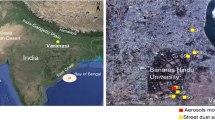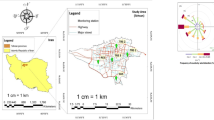Abstract
Contamination from microplastics is a growing concern around the globe that materialized over the last few decades. Road dust is one of the main contributors of microplastics in an urban environment and presence of microplastics can be a major detriment to health of urban population. The present study focuses on the presence, quantification, and identification of microplastics in the ambient air. Coarse (PM10) and fine (PM2.5) particulates from urban and rural sites of Nagpur, India is collected using high volume air samplers for weekdays and weekends for a period of 24 h. Samples are collected in Polytetrafluoroethylene filter papers and are analyzed using a stereomicroscope, fluorescence microscopic study, and Fourier transform infrared spectroscopy (FTIR) analysis. Fluorescence microscopy is conducted using Nile Red staining for analyzing the presence of microplastics and studying its shapes and colors. An average total abundance ranging from 50 to 120 particles/day is observed. Fibers are the dominant shape, and transparent/white is the dominant color observed in all four sites. FTIR analysis is conducted for identification of the chemical composition of particles in Attenuated Reflectance mode. The polymers identified in the region are low-density polyethylene, rayon, rubber fiber, polystyrene, polyaniline, polyolefin, and chlorinated polyvinyl chloride. This research identified significant contamination of the study region from microplastics and highlights the necessity of performing a comprehensive health risk analysis of the study region to examine the impact of microplastics on urban health.
Article Highlights
-
PM10 and PM2.5 samples are collected from urban and rural environment of Nagpur, India
-
Microplastic particles collected from particulate samples are classified based on shape and colour
-
White/transparent and Fibrous microplastics are found to contribute most to the study region
-
Least contribution is from spherical and coloured microplastics
-
Polyethylene is the dominant polymer identified in the study region







Similar content being viewed by others
References
Abbasi S, Keshavarzi B, Moore F et al (2017) Investigation of microrubbers, microplastics and heavy metals in street dust: a study in Bushehr city, Iran. Environ Earth Sci 76:798
Abbasi S, Keshavarzi B, Moore F et al (2019) Distribution and potential health impacts of microplastics and microrubbers in air and street dusts from Asaluyeh County, Iran. Environ Pollut 244:153–164
Abderrahim B, Abderrahman E, Mohamed A et al (2015) Kinetic thermal degradation of cellulose, polybutylene succinate and a green composite: comparative study. World J Env Eng 3:95–110
Ambrosini R, Azzoni RS, Pittino F et al (2019) First evidence of microplastic contamination in the supraglacial debris of an alpine glacier. Environ Pollut 253:297–301
Asensio RC, Moya MSA, de la Roja JM, Gómez M (2009) Analytical characterization of polymers used in conservation and restoration by ATR-FTIR spectroscopy. Anal Bioanal Chem 395:2081–2096
Barnes DK, Galgani F, Thompson RC, Barlaz M (2009) Accumulation and fragmentation of plastic debris in global environments. Philos Trans R Soc B Biol Sci 364:1985–1998
Browne MA, Crump P, Niven SJ et al (2011) Accumulation of microplastic on shorelines woldwide: sources and sinks. Environ Sci Technol 45:9175–9179
Cai L, Wang J, Peng J et al (2017) Characteristic of microplastics in the atmospheric fallout from Dongguan city, China: preliminary research and first evidence. Environ Sci Pollut Res 24:24928–24935
Choi JS, Jung Y-J, Hong N-H et al (2018) Toxicological effects of irregularly shaped and spherical microplastics in a marine teleost, the sheepshead minnow (Cyprinodon variegatus). Mar Pollut Bull 129:231–240
Cole M, Lindeque P, Halsband C, Galloway TS (2011) Microplastics as contaminants in the marine environment: a review. Mar Pollut Bull 62:2588–2597
Cox KD, Covernton GA, Davies HL et al (2019) Human consumption of microplastics. Environ Sci Technol 53:7068–7074
Dauvergne P (2018) Why is the global governance of plastic failing the oceans? Glob Environ Change 51:22–31
Dehghani S, Moore F, Akhbarizadeh R (2017) Microplastic pollution in deposited urban dust, Tehran metropolis, Iran. Environ Sci Pollut Res 24:20360–20371
De Falco F, Di Pace E, Cocca M, Avella M (2019) The contribution of washing processes of synthetic clothes to microplastic pollution. Sci Rep 9:6633
Deng Y, Zhang Y, Lemos B, Ren H (2017) Tissue accumulation of microplastics in mice and biomarker responses suggest widespread health risks of exposure. Sci Rep 7:46687
Dilara P, Briassoulis D (1998) Standard testing methods for mechanical properties and degradation of low density polyethylene (LDPE) films used as greenhouse covering materials: a critical evaluation. Polym Test 17:549–585
Dilara P, Briassoulis D (2000) Degradation and stabilization of low-density polyethylene films used as greenhouse covering materials. J Agric Eng Res 76:309–321
Dris R, Gasperi J, Rocher V et al (2015) Microplastic contamination in an urban area: a case study in Greater Paris. Environ Chem 12:592–599
Dris R, Gasperi J, Saad M et al (2016) Synthetic fibers in atmospheric fallout: a source of microplastics in the environment? Mar Pollut Bull 104:290–293
Erni-Cassola G, Gibson MI, Thompson RC, Christie-Oleza JA (2017) Lost, but found with Nile Red: a novel method for detecting and quantifying small microplastics (1 mm to 20 μm) in environmental samples. Environ Sci Technol 51:13641–13648
Eyles J, Bramwell V, Williamson E, Alpar H (2001) Microsphere translocation and immunopotentiation in systemic tissues following intranasal administration. Vaccine 19:4732–4742
Galloway TS (2015) Micro-and nano-plastics and human health. Marine anthropogenic litter. Springer, Cham, pp 343–366
Galvão A, Aleixo M, De Pablo H et al (2020) Microplastics in wastewater: microfiber emissions from common household laundry. Environ Sci Pollut Res 27:26643–26649
Gatidou G, Arvaniti OS, Stasinakis AS (2019) Review on the occurrence and fate of microplastics in Sewage Treatment Plants. J Hazard Mater 367:504–512
Hodson ME, Duffus-Hodson CA, Clark A et al (2017) Plastic bag derived-microplastics as a vector for metal exposure in terrestrial invertebrates. Environ Sci Technol 51:4714–4721
Holmes LA, Turner A, Thompson RC (2012) Adsorption of trace metals to plastic resin pellets in the marine environment. Environ Pollut 160:42–48
Hospodarova V, Singovszka E, Stevulova N (2018) Characterization of cellulosic fibers by FTIR spectroscopy for their further implementation to building materials. Am J Anal Chem 9:303–310
Jani P, Halbert GW, Langridge J, Florence AT (1990) Nanoparticle uptake by the rat gastrointestinal mucosa: quantitation and particle size dependency. J Pharm Pharmacol 42:821–826
Jovanović B (2017) Ingestion of microplastics by fish and its potential consequences from a physical perspective. Integr Environ Assess Manag 13:510–515
Jung MR, Horgen FD, Orski SV et al (2018) Validation of ATR FT-IR to identify polymers of plastic marine debris, including those ingested by marine organisms. Mar Pollut Bull 127:704–716
Kang H-J, Park H-J, Kwon O-K et al (2018) Occurrence of microplastics in municipal sewage treatment plants: a review. Environ Health Toxicol 33:1–8
Kotharkar R, Bagade A (2018) Local Climate Zone classification for Indian cities: a case study of Nagpur. Urban Clim 24:369–392
Kotharkar R, Bahadure P, Sarda N (2014) Measuring compact urban form: a case of Nagpur City, India. Sustainability 6:4246–4272
Landon-Lane M (2018) Corporate social responsibility in marine plastic debris governance. Mar Pollut Bull 127:310–319
Löder MGJ, Kuczera M, Mintenig S et al (2015) Focal plane array detector-based micro-Fourier-transform infrared imaging for the analysis of microplastics in environmental samples. Environ Chem 12:563–581
Lu Y, Zhang Y, Deng Y et al (2016) Uptake and accumulation of polystyrene microplastics in zebrafish (Danio rerio) and toxic effects in liver. Environ Sci Technol 50:4054–4060
Napper IE, Bakir A, Rowland SJ, Thompson RC (2015) Characterisation, quantity and sorptive properties of microplastics extracted from cosmetics. Mar Pollut Bull 99:178–185
Nor NHM, Obbard JP (2014) Microplastics in Singapore’s coastal mangrove ecosystems. Mar Pollut Bull 79:278–283
Paytan A, Mackey KR, Chen Y et al (2009) Toxicity of atmospheric aerosols on marine phytoplankton. Proc Natl Acad Sci 106:4601–4605
Prata JC (2018) Airborne microplastics: consequences to human health? Environ Pollut 234:115–126
Prata JC, da Costa JP, Lopes I et al (2020) Environmental exposure to microplastics: an overview on possible human health effects. Sci Total Environ 702:134455
Qiu R, Song Y, Zhang X et al (2020) Microplastics in urban environments: sources, pathways, and distribution. In: He D, Luo Y (eds) Microplastics in terrestrial environments: emerging contaminants and major challenges. Springer International Publishing, Cham, pp 41–61
Revel M, Châtel A, Mouneyrac C (2018) Micro (nano) plastics: a threat to human health? Curr Opin Environ Sci Health 1:17–23
Rezania S, Park J, Din MFM, Taib SM, Talaiekhozani A, Yadav KK, Kamyab H (2018) Microplastics pollution in different aquatic environments and biota: A review of recent studies. Marine pollut bull 133:191–208
Rivers N, Shenstone-Harris S, Young N (2017) Using nudges to reduce waste? The case of Toronto’s plastic bag levy. J Environ Manag 188:153–162
Rochman CM, Parnis JM, Browne MA et al (2017) Direct and indirect effects of different types of microplastics on freshwater prey (Corbicula fluminea) and their predator (Acipenser transmontanus). PLoS One 12:1–18
Shim WJ, Song YK, Hong SH, Jang M (2016) Identification and quantification of microplastics using Nile Red staining. Mar Pollut Bull 113:469–476
Sigler M (2014) The effects of plastic pollution on aquatic wildlife: current situations and future solutions. Water Air Soil Pollut 225:2184
Sommer F, Dietze V, Baum A et al (2018) Tire abrasion as a major source of microplastics in the environment. Aerosol Air Qual Res 18:2014–2028
Sternschuss G, Ostergard DR, Patel H (2012) Post-implantation alterations of polypropylene in the human. J Urol 188:27–32
Valavanidis A, Vlachogianni T, Fiotakis K, Loridas S (2013) Pulmonary oxidative stress, inflammation and cancer: respirable particulate matter, fibrous dusts and ozone as major causes of lung carcinogenesis through reactive oxygen species mechanisms. Int J Environ Res Public Health 10:3886–3907
Verschoor A, de Poorter L et al (2016) Emission of microplastics and potential mitigation measures: Abrasive cleaning agents, paints and tyre wear, Rijksinstituut voor Volksgezondheid en Milieu (RIVM) report 2016-0026. 1–76
Wang T, Zou X, Li B et al (2019) Preliminary study of the source apportionment and diversity of microplastics: taking floating microplastics in the South China Sea as an example. Environ Pollut 245:965–974
Weinstein JE, Crocker BK, Gray AD (2016) From macroplastic to microplastic: degradation of high-density polyethylene, polypropylene, and polystyrene in a salt marsh habitat. Environ Toxicol Chem 35:1632–1640
Wick P, Malek A, Manser P et al (2010) Barrier capacity of human placenta for nanosized materials. Environ Health Perspect 118:432–436
Yin L, Wen X, Du C et al (2020) Comparison of the abundance of microplastics between rural and urban areas: a case study from East Dongting Lake. Chemosphere 244:125486
Zhang H (2017) Transport of microplastics in coastal seas. Estuar Coast Shelf Sci 199:74–86
Funding
The authors have received no specific grant from funding agencies in the public, commercial, or not-for-profit sectors for this research.
Author information
Authors and Affiliations
Corresponding author
Ethics declarations
Conflict of interest
The authors declare no conflict of interest.
Electronic supplementary material
Below is the link to the electronic supplementary material.
Rights and permissions
About this article
Cite this article
Narmadha, V.V., Jose, J., Patil, S. et al. Assessment of Microplastics in Roadside Suspended Dust from Urban and Rural Environment of Nagpur, India. Int J Environ Res 14, 629–640 (2020). https://doi.org/10.1007/s41742-020-00283-0
Received:
Revised:
Accepted:
Published:
Issue Date:
DOI: https://doi.org/10.1007/s41742-020-00283-0




